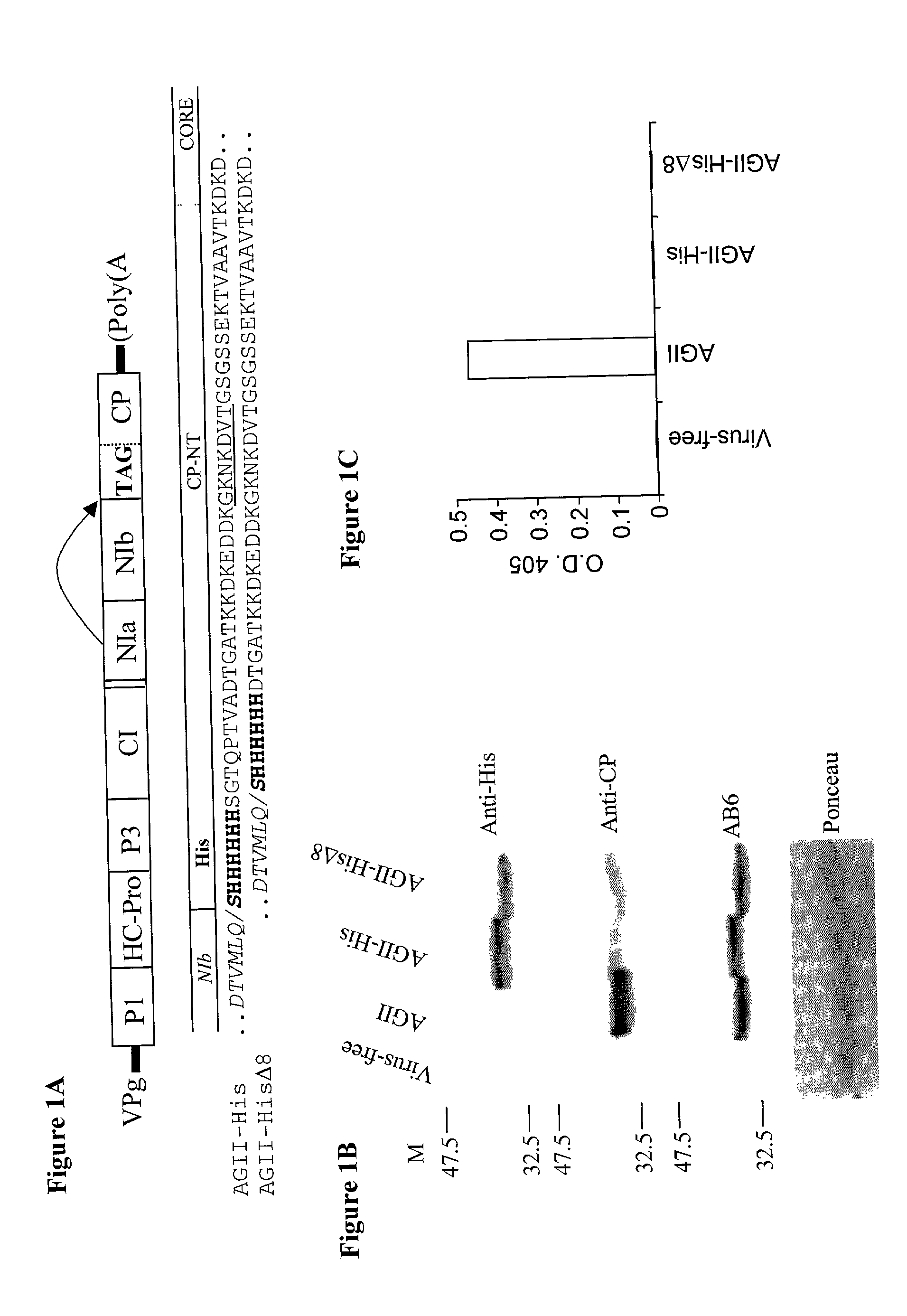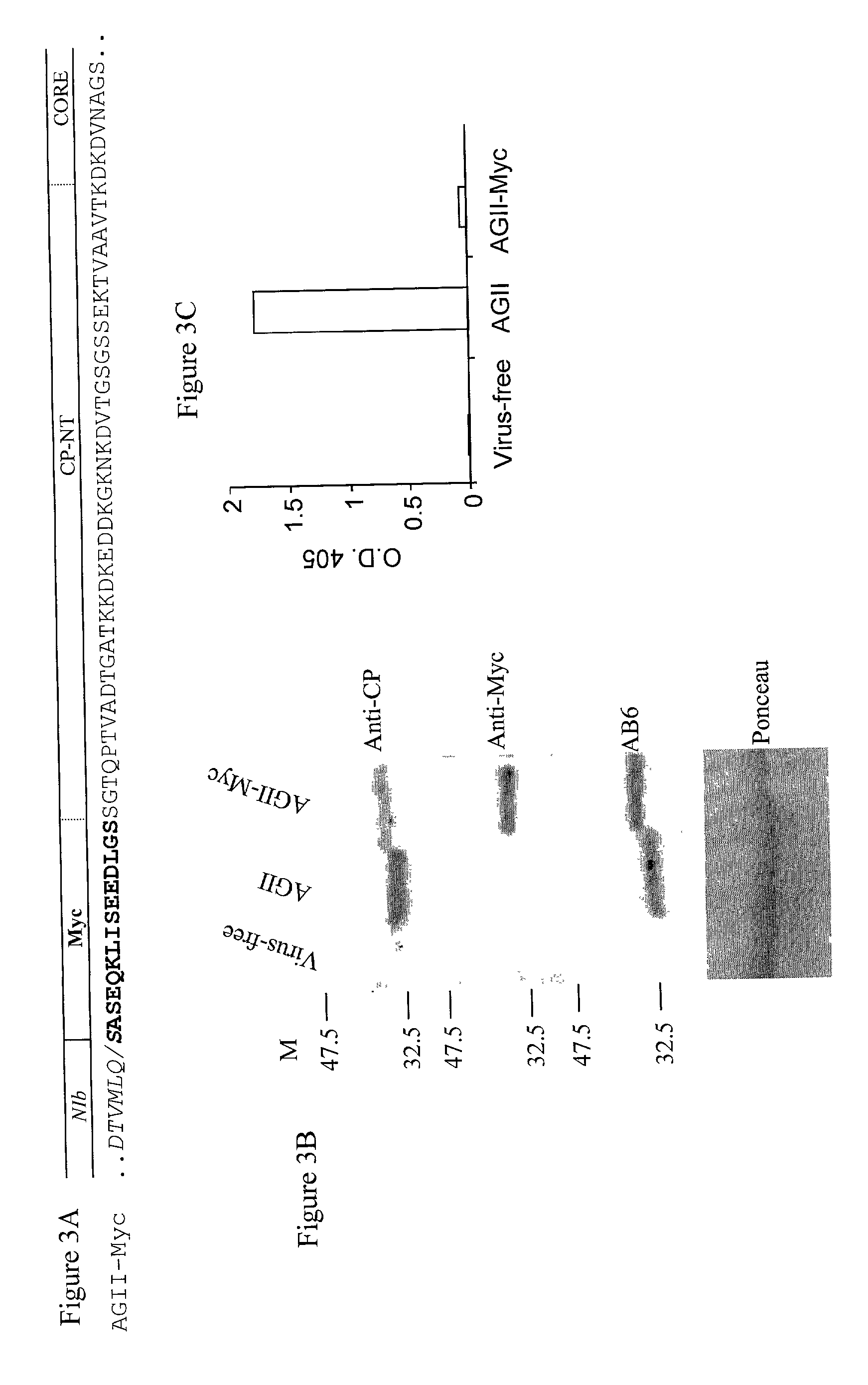Vectors for expressing heterologous peptides at the amino-terminus of potyvirus coat protein, methods for use thereof, plants infected with same and methods of vaccination using same
a technology of heterologous peptides and vectors, which is applied in the field of vectors for expressing heterologous peptides at the amino-terminus of potyvirus coat protein, can solve the problems of unsuitability of potyviruses as vectors for expressing biologically important peptides, patents do not include viruses, etc., and achieve the effect of facilitating proteolytic excision of the coat protein
- Summary
- Abstract
- Description
- Claims
- Application Information
AI Technical Summary
Benefits of technology
Problems solved by technology
Method used
Image
Examples
example 1
Examination of the ability of AGII containing a foreign peptide fused to the N-terminus of the coat protein to accumulate and systemically infect an inoculated plant
[0129] In order to evaluate the AGII (SEQ ID Nos.: 1 and 2) potyvirus as an epitope presentation system, a 21-nucleotide sequence encoding a seven-residue peptide (six histidines with a serine residue at its N-terminus' (SEQ ID NOs.: 4 and 5) was cloned into the AGII genome either with or without N-terminal deletions of the CP.
[0130] The serine residue was added to the histidine tag in order to enable processing of the potyvirus polyprotein by the NIa protease (Riechmann, J. L., et al. (1992). J. Gen. Virol. 73:1-16 and FIG. 1A). This created a translational fusion of the cloned sequence with either a full-length CP (AGII-His; FIG. 1A; SEQ ID NO.: 6) or with a truncated CP lacking eight amino acid residues from its N-terminal (AGII-His.DELTA.8; FIG. 1A; SEQ ID No.: 7). A cDNA containing AGII with a similar CP truncation ...
example 2
Presentation of a heterologous peptide fused to the N-terminus of CP on the viral coat
[0135] In order to determine whether the fused His-tag (SEQ ID NOs.: 4 and 5) is exposed on the viral surface, virions were tested under native condition for their ability to bind to an Ni.sup.2+ affinity column. This column is known to bind exposed clusters of His residues (Schmitt, J., et al. (1993) Mol. Biol. Reports 18: 223-230). Soluble extracts from AGII-His (SEQ ID NO.: 6), AGII-His.DELTA.8 (SEQ ID NO.: 7) and AGII (SEQ ID NO.: 1) systemically infected squash leaves were subjected to Ni.sup.2+ affinity chromatography. Ni.sup.2+ binding virions were eluted with 300 mM imidazole. An equal volume from each fraction was analyzed by immunoblot. A protein of the same gel mobility as AGII CP was immuno-detected by anti-His antibody in the fractions eluted from AGII-His and AGII-His.DELTA.8 Ni.sup.2+ affinity columns (FIG. 2A, fractions E2-E5) but not in similar fractions from AGII Ni.sup.2+ affinit...
example 3
Fusion of larger heterologous peptides to the N-terminus of CP
[0137] In order to determine whether a foreign peptide longer than seven amino acid residues would support virus assembly and systemic infection, a 48 nucleotide sequence encoding a sixteen amino acid peptide (SEQ ID NOs.: 8 and 9 respectively) from the human c-myc (Myc; 11) was cloned into the AGII genome to create a translational fusion with CP (AGII-Myc; FIG. 3A; SEQ ID NO.: 10). Recombinant AGII-Myc cDNA was able to infect cucurbits seedlings systemically as efficiently as AGII.
[0138] The AGII-Myc chimeric virus was genetically stable in plants and kept the Myc-tag intact for at least 60 days and 3 subsequent passages in squash plants, as determined by RT-PCR of viral progeny and direct sequencing of the amplified product. Accumulation of Myc-CP fusion protein in systemically infected squash leaves was analyzed by western blot analysis with anti-CP and anti-Myc antibodies. A band, with slightly slower gel mobility tha...
PUM
| Property | Measurement | Unit |
|---|---|---|
| volume | aaaaa | aaaaa |
| pH | aaaaa | aaaaa |
| pH | aaaaa | aaaaa |
Abstract
Description
Claims
Application Information
 Login to View More
Login to View More - R&D
- Intellectual Property
- Life Sciences
- Materials
- Tech Scout
- Unparalleled Data Quality
- Higher Quality Content
- 60% Fewer Hallucinations
Browse by: Latest US Patents, China's latest patents, Technical Efficacy Thesaurus, Application Domain, Technology Topic, Popular Technical Reports.
© 2025 PatSnap. All rights reserved.Legal|Privacy policy|Modern Slavery Act Transparency Statement|Sitemap|About US| Contact US: help@patsnap.com



